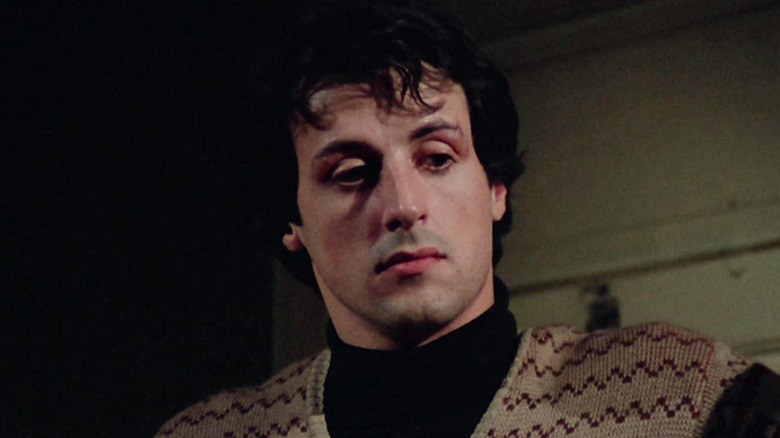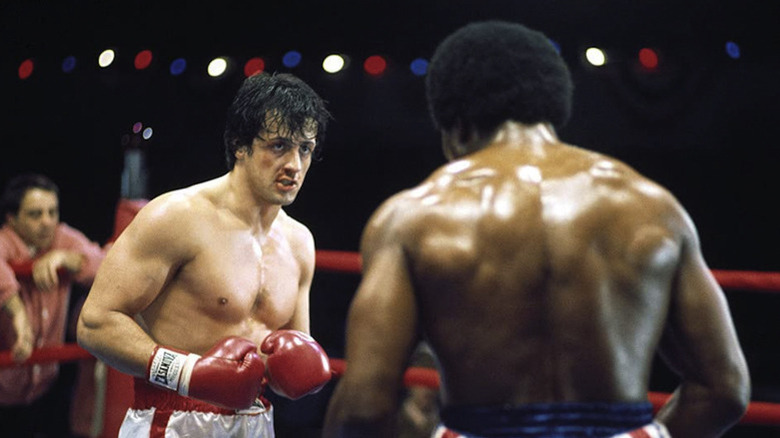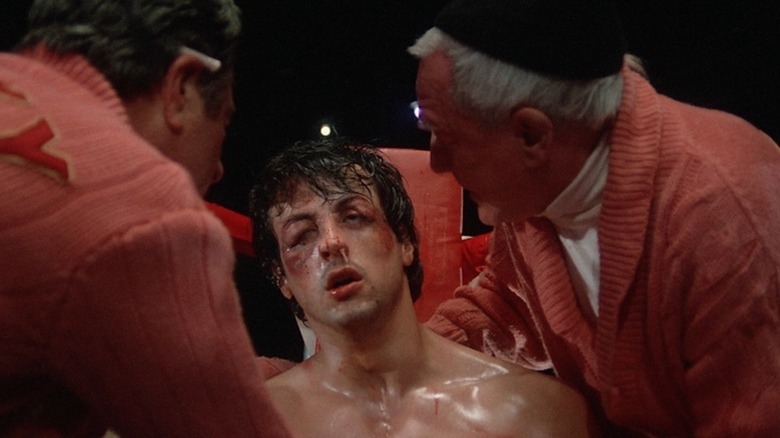Why Every Round Of Sylvester Stallone And Carl Weathers' Rocky Finale Fight Was Shot Twice
"Rocky" has endured as one of the most uplifting sports films of all time thanks in large part to its heartfelt portrayal of two social misfits falling haltingly in love as one of them trains for an unlikely, yet plausible shot at the heavyweight boxing title. Sylvester Stallone and Talia Shire give lovely, lived-in performances that are painful to watch at times because Rocky has no idea how awkwardly his gregariousness lands, while Adrian seems terrified that anyone would find her worthy of affection.
For most of its runtime, "Rocky" is a human drama about losers. It soars to life during its Bill Conti-scored training montage that explodes the film into its exhilarating third act. Interestingly, the final match isn't all that long. From the opening bell to the end of the fifteenth round, it occupies a scant eight-and-a-half minutes of screen time. But it feels like trench warfare thanks to the Academy Award-winning editing of Richard Halsey and Scott Conrad, and John G. Avildsen's clever direction, which employed state-of-the-art technology to bring the audience into the ring.
Rocky put the audience in the ring
Prior to "Rocky," boxing matches in movies played static. You could set up dolly tracks outside of the ring to give viewers a sense of fluidity, but anything inside the ring was probably going to be handheld or on sticks. This didn't mean you couldn't film a memorable boxing match (Mark Robson's 1949 noir "Champion" closes with a viscerally unsettling bout); you just weren't going to give moviegoers anything they hadn't seen.
Garrett Brown's 1975 invention of the Steadicam changed this. One year later, masters like Hal Ashby and John Schlesinger added the newfangled rig to their technical palette in, respectively, "Bound for Glory" and "Marathon Man." But the stabilized camera was practically tailor-made for "Rocky." Avildsen could get inside the ropes with Stallone and Carl Weathers to give audiences a face-mangling, rib-cracking fight for the ages. But doing so would require the director to film the bout twice and in reverse.
Per Adam K. Raymond's 40th anniversary appreciation of "Rocky" for Yahoo! Movies:
"When the big day arrived, Avildsen began by shooting the final round first. This allowed the gradual removal of the makeup and prosthetics Stallone and Weathers needed to make their faces look like they'd been through 15 rounds. The actors performed each round twice, once with cameras shooting through the ropes from outside the ring — a touch Avildsen said added to the realism — and another time with Steadicam operator Garrett Brown circling them in the ring."
Rocky the agonist
Boxing was still boxing in 1976, by which I mean that a title bout could pack a massive movie house with a closed-circuit presentation. The heavyweight division was at its competitive apex: Muhammad Ali, Joe Frazier, George Foreman, Ken Norton, Leon Spinks, and Larry Holmes were all legitimate contenders. Year after year, fans were witness to some of the greatest matches in the history of the sport. But they'd never seen a fight like Balboa–Creed.
47 years later, the human carnage of that bout would never be allowed to take place – which is a good thing. The ring doctor would've called it for Balboa due to Creed's internal bleeding (if not earlier due to the out-of-control swelling around Rocky's eye). This is likely true of those wild, real-life slugfests that turned kids like me into lifelong boxing fans. But I don't know that I would've been as devoted to the Sweet Science had I not seen "Rocky" at a young, impressionable age. That film captured not just the grit and glory of the sport, but its essential terror and loneliness. Sugar Ray Leonard once told me that, in those late rounds with Roberto Durán and Marvin Hagler, he was afraid he might die. I never felt that watching those fights on television, but I sure as hell got it watching "Rocky." And it's all because of that in-the-clinches proximity of the Steadicam.


